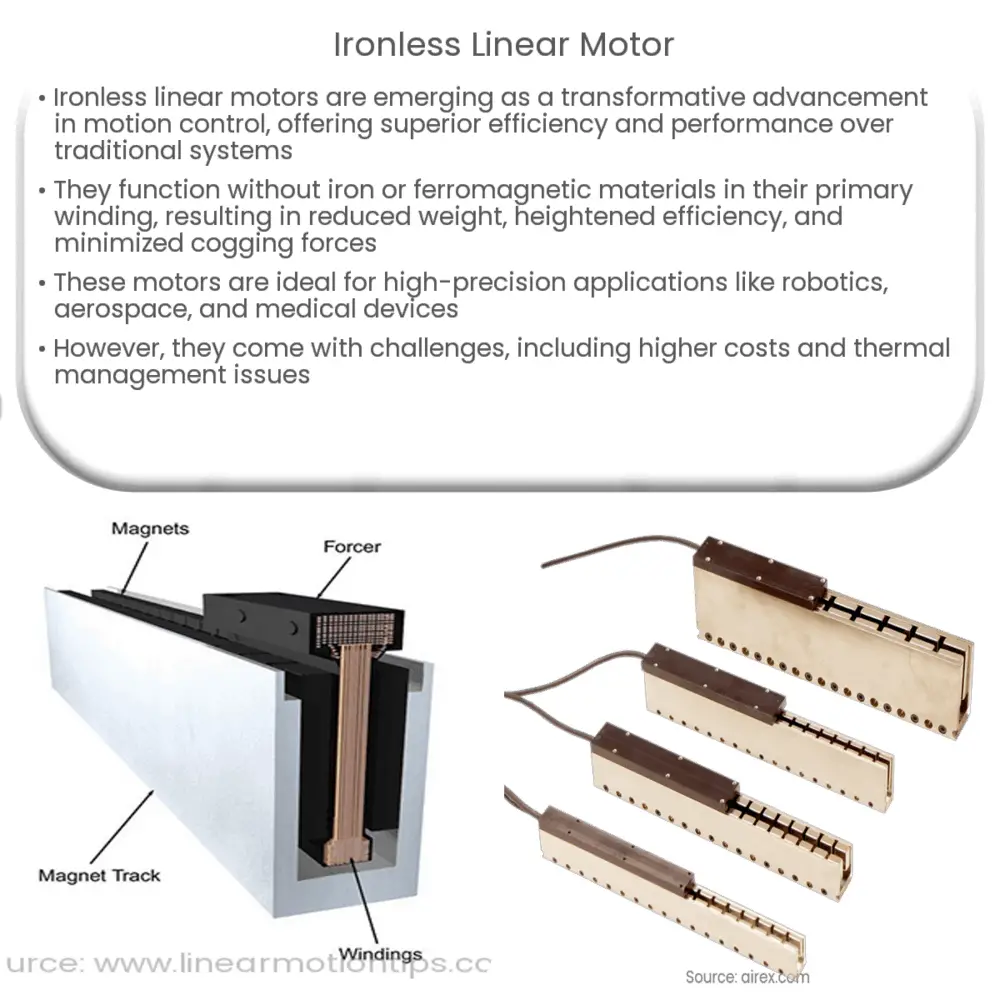Ironless linear motors provide smooth, precise motion control with reduced weight and increased efficiency, ideal for high-precision applications.

Ironless Linear Motors: The Future of Motion Control
In recent years, technological advancements have revolutionized the way we control motion in various industries. Ironless linear motors have emerged as one of the most significant breakthroughs in this field, offering improved performance and efficiency compared to traditional motion control systems. This article will discuss the benefits of ironless linear motors, how they work, and the potential applications for this cutting-edge technology.
What are Ironless Linear Motors?
Ironless linear motors are a type of direct drive motor that operates without the use of any iron or ferromagnetic materials in their primary winding. This innovative design offers several advantages over traditional linear motors, including reduced weight, increased efficiency, and minimized cogging forces. As a result, these motors are becoming increasingly popular in high-precision applications where smooth and accurate motion is essential.
How do Ironless Linear Motors Work?
Ironless linear motors consist of two main components: a primary part called the forcer, which contains the motor’s windings, and a secondary part known as the platen, which features a series of permanent magnets. The forcer and platen are designed to work in tandem, with the forcer generating an electromagnetic field that interacts with the magnetic field created by the platen’s magnets. This interaction produces a force that propels the forcer along the platen in a linear motion.
One of the key innovations in ironless linear motor design is the elimination of iron from the primary winding. This is achieved by using a unique winding configuration known as a “pancake” or “flat” winding, where the copper windings are arranged in a flat, spiral pattern. This design helps to minimize the motor’s inductance, resulting in faster response times and increased efficiency.
Benefits of Ironless Linear Motors
Ironless linear motors offer several advantages over traditional linear motor designs, including:
- Reduced Weight: By eliminating iron from the primary winding, ironless linear motors are significantly lighter than their iron-core counterparts. This reduced weight can be particularly beneficial in applications where minimizing system inertia is important, such as robotics and aerospace.
- Increased Efficiency: The unique winding configuration of ironless linear motors results in lower inductance, which allows the motor to operate more efficiently. This can lead to reduced energy consumption and lower operating costs.
- Minimized Cogging Forces: Cogging forces are undesirable fluctuations in motor force that can cause unwanted vibrations and reduce overall system accuracy. Ironless linear motors are designed to minimize these forces, resulting in smoother and more precise motion control.
Potential Applications for Ironless Linear Motors
Thanks to their impressive performance characteristics, ironless linear motors are well-suited for a variety of high-precision applications, including:
- Robotics
- Semiconductor manufacturing equipment
- Medical devices
- Aerospace systems
- Precision machining equipment
As technology continues to advance, it’s likely that ironless linear motors will play an increasingly important role in the future of motion control. Their unique combination of lightweight design, high efficiency, and precise operation make them an attractive option for industries requiring advanced motion control solutions.
Challenges and Limitations
While ironless linear motors offer numerous advantages, there are some challenges and limitations to consider when implementing them in certain applications:
- Cost: Due to the specialized design and manufacturing processes required for ironless linear motors, they tend to be more expensive than traditional iron-core linear motors. This may be a consideration for budget-conscious projects or high-volume applications where cost is a primary concern.
- Thermal Management: The absence of iron in the primary winding reduces the motor’s ability to dissipate heat. This may require additional cooling measures, such as air or liquid cooling, to ensure the motor operates within its optimal temperature range.
- Force Density: Ironless linear motors typically have a lower force density compared to their iron-core counterparts. This may limit their suitability in applications requiring high force generation in a compact space.
Choosing the Right Motor for Your Application
When selecting a linear motor for a specific application, it’s essential to consider factors such as required force, speed, precision, and budget. Ironless linear motors excel in situations that demand high precision, low cogging, and rapid acceleration. However, they may not be the best choice for all applications, especially those with high force requirements or budget constraints.
To make an informed decision, it’s crucial to work closely with a motor manufacturer or distributor with expertise in linear motor technology. They can help assess your specific requirements and recommend the most suitable motor solution for your application.
Conclusion
Ironless linear motors represent a significant advancement in motion control technology, offering numerous benefits such as reduced weight, increased efficiency, and minimized cogging forces. These motors have the potential to transform industries that require high-precision motion control, including robotics, semiconductor manufacturing, medical devices, aerospace, and precision machining.
However, it’s important to be aware of the challenges and limitations associated with ironless linear motors and carefully consider whether they are the right fit for your specific application. By working with experienced motor experts and thoroughly evaluating your requirements, you can determine if an ironless linear motor is the best solution for your motion control needs.
As technology continues to evolve, we can expect to see further advancements in ironless linear motor design, leading to improved performance and expanded applications. These motors are poised to play a significant role in shaping the future of motion control, offering unparalleled precision and efficiency in a wide range of industries.

